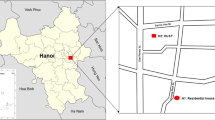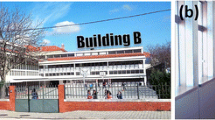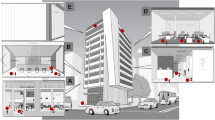Abstract
Assessment of indoor air quality (IAQ) in classrooms of school buildings is of prime concern due to its potential effects on student’s health and performance as they spend a substantial amount of their time (6–7 h per day) in schools. A number of airborne contaminants may be present in urban school environment. However, respirable suspended particulate matter (RSPM) is of great significance as they may significantly affect occupants’ health. The objectives of the present study are twofold, one, to measure the concentrations of PM10 (<10 \(\upmu \)m), PM2.5 (<2.5 \(\upmu \)m), and PM1.0 (<1.0 \(\upmu \)m) in naturally ventilated classrooms of a school building located near a heavy-traffic roadway (9,755 and 4,296 vehicles/hour during weekdays and weekends, respectively); and second, to develop single compartment mass balance-based IAQ models for PM10 (NVIAQMpm10), PM2.5 (NVIAQMpm2.5), and PM1.0 (NVIAQMpm1.0) for predicting their indoor concentrations. Outdoor RSPM levels and classroom characteristics, such as size, occupancy level, temperature, relative humidity, and CO2 concentrations have also been monitored during school hours. Predicted indoor PM10 concentrations show poor correlations with observed indoor PM10 concentrations (R 2 = 0.028 for weekdays, and 0.47 for weekends). However, a fair degree of agreement (d) has been found between observed and predicted concentrations, i.e., 0.42 for weekdays and 0.59 for weekends. Furthermore, NVIAQMpm2.5 and NVIAQMpm1.0 results show good correlations with observed concentrations of PM2.5 (R 2 = 0.87 for weekdays and 0.9 for weekends) and PM1.0 (R 2 = 0.86 for weekdays and 0.87 for weekends). NVIAQMpm10 shows the tendency to underpredict indoor PM10 concentrations during weekdays as it does not take into account the occupant’s activities and its effects on the indoor concentrations during the class hours. Intense occupant’s activities cause resuspension or delayed deposition of PM10. The model results further suggests conductance of experimental and physical simulation studies on dispersion of particulates indoors to investigate their resuspension and settling behavior due to occupant’s activities/movements. The models have been validated at three different classroom locations of the school site. Sensitivity analysis of the models has been performed by varying the values of mixing factor (k) and newly introduced parameter R c. The results indicate that the change in values of k (0.33 to 1.00) does not significantly affect the model performance. However, change in value of R c (0.001 to 0.500) significantly affects the model performance.
Similar content being viewed by others
References
ASHRAE (1993). ASHRAE fundamentals handbook, ventilation, air conditioning, and refrigeration systems. Inc. ASHRAE, Atlanta.
Bennett, D. H., & Koutrakis, P. (2006). Determining the infiltration of outdoor particles in the indoor environment using a dynamic model. Journal of Aerosol Science, 37, 766–785.
Branis, M., Rezacova, P., & Domasova, M. (2005). The effect of outdoor air and indoor human activity on mass concentration of PM10, PM2.5, and PM1 in a classroom. Environmental Research, 99, 143–149.
Chaloulakou, A., & Mavroidis, I. (2002). Comparison of indoor and outdoor concentrations of CO at a public school. Evaluation of an indoor air quality model. Atmospheric Environment, 36(11), 1769–1781.
Chang, T. J., Hsieh, Y. F., & Kao, H. M. (2006). Numerical investigation of airflow pattern and particulate matter transport in naturally ventilated multi-room buildings. Indoor Air, 16(2), 136–152.
Commission on Life Sciences (1981). Indoor pollutants. Washington, D.C.: National Academy Press
Dockery, D. W., & Spengler, J. D. (1981). Indoor and outdoor relationships of respirable sulfates and particles. Atmospheric Environment, 15, 335–343.
Esmen, N. A. (1978). Characterization of contaminant concentrations in enclosed spaces. Environmental Science and Technology, 12, 337–339.
Ferro, A. R., Kopperud, R. J., & Hildmann, L. M. (2004). Source strength for indoor human activities that resuspend particulate matter. Environmental Science & Technology, 38(6), 1759–1764.
Friess, H., & Yadigaroglu, G. (2002). Modeling of the resuspension of particle clusters from multilayer aerosol deposits with variable porosity. Journal of Aerosol Science, 33, 883–906.
Gomes, C., Freihaut, J., & Bahnfleth, W. (2007). Resuspension of allergen-containing particles under mechanical and aerodynamic disturbances from human walking. Atmospheric Environment, 41, 5257–5270.
Goyal, R., & Khare, M. (2009). Indoor–outdoor concentrations of RSPM in classroom of a naturally ventilated school building near an urban traffic roadway. Atmospheric Environment, 43(38), 6026–6038.
GRIMM Aerosol Technik, GmbH & Co. Germany (2003). Environmental dust monitor, model 107 and weather housing, model 165.
Hayes, S. R. (1989). Estimating the effect of being indoors on total personal exposure to outdoor air pollution. Journal of the Air Pollution Control Association, 39(11), 1453–1461.
Hayes, S. R. (1991). Use of an indoor air quality model (IAQM) to estimate indoor ozone levels. Journal of the Air and Waste Management Association, 41(2), 161–170.
Hinds, W. C. (1999). Aerosol technology: Properties, behavior, and measurement of airborne particles. New York: Wiley.
Hu, B., Freihaut, J. D., Bahnfleth, W., Gomes, C. A. S., & Thran, B. (2008). Literature review and parametric study: Indoor particle resuspension by human activity, (online available).
Hussein, T., Glytsos, T., Ondra, J., Dohanyosova, P., Zdımal, V., Hameri, K., et al. (2006). Particle size characterization and emission rates during indoor activities in a house. Atmospheric Environment, 40, 4285–4307.
Jamriska, M., Morawska, L., & Ensor, D. S. (2003). Control strategies for sub-micrometer particles indoors: Model study of air filtration and ventilation. Indoor Air, 13(2), 96–105.
Jones, N. C., Thornton, C. A., Mark, D., & Harrison, R. M. (2000). Indoor/outdoor relationships of particulate matter in domestic homes with roadside, urban and rural locations. Atmospheric Environment, 34, 2603–2612.
Juda, K. (1986). Modelling of the air pollution in the cracow area. Atmospheric Environment, 20(12), 2249–2258.
Karlsson, E., Berglund, T., Stromqvist, M., Nordstrand, M., & Fangmark, I. (1999). The effect of resuspension caused by human activities on the indoor concentration of biological aerosols. Journal Aerosol Science, 30(1), 737–738.
Kolokotroni, M., Ge, Y. T., & Katsoulas, D. (2002). Monitoring and modelling indoor air quality and ventilation in classroom within a purpose-designed naturally ventilated school. Indoor & Built Environment, 11, 316–326.
Lazaridis, M., & Drossinos, Y. (1998). Multilayer resuspension of small identical particles by turbulent flow. Aerosol Science and Technology, 28(6), 548–560.
Li, Y., & Chan, Z. (2003). A balance-point method for assessing the effect of natural ventilation on indoor particle concentrations. Atmospheric Environment, 37(30), 4277–4285.
Matson, U. (2005). Comparison of the modelling and the experimental results on concentrations of ultra-fine partcles indoors. Building and Environment, 40, 996–1002.
Mendall, M. J., & Heath, G. A. (2005). Do indoor pollutants and thermal conditions in schools influence student performance? A critical review of the literature. Indoor Air, 15(1), 27–52.
Monn, C. (2001). Exposure assessment of air pollutants: A review on special heterogeneity and indoor/ outdoor/personal exposure to suspended particulate matter, nitrogen dioxide and ozone. Atmospheric Environment, 35, 1–32.
Morawska, L., Hee, C., Hitcins, J., Gilbert, D., & Parappukkaran, S. (2001). The relationship between indoor and outdoor airborne particles in the residential environment. Atmospheric Environment, 35(20), 3463–3473.
Oberdorster, G., Ferin, J., Gelein, R., & Weiss, B. (1995). Association of particulate air pollution and acute mortality: Involvement of ultrafine particles. Inhalation Toxicology, 7, 111–124.
Peters, A., Wichmann, H. E., Tuch, T., Heinrich, J., & Heyder, J. (1997). Respiratory effects are associated with the number of ultrafine particles. American Journal of Respiratory and Critical Care Medicine, 155, 1376–1383.
Pope, C. A., Dockery, D. W., & Schwartz, J. (1995). Review of epidemiological evidence of health effects of particulate air pollution. Inhalation Toxicology, 7, 1–18.
Posner, J. D., Buchanan, C. R., & Dunn-Rankin, D. (2003). Measurement and prediction of indoor air flow in a model room. Energy and Buildings, 35(5), 515–526.
Quest technologies (2000). IAQ monitor. Wisconsin: Quest technologies.
Riain, C. M., Mark, D., Davies, M., Harrison, R. M., & Byrne, M. A. (2003). Averaging periods for indoor–outdoor ratios of pollution in naturally ventilated non-domestic buildings near a busy road. Atmospheric Environment, 37, 4121–4132.
Seaton, A., MacNee, W., Donaldson, K., & Godden, D. (1995). Particulate air pollution and acute health effects. Lancet, 345, 176–178.
Sheff, P. A., Paulius, V. K., Huang, S. W., & Conroy, L. M. (2000). Indoor air quality in a middle school, part I: Use of CO2 as a trace for effective ventilation. Applied Occupational and Environmental Hygiene, 15(11), 824–834.
Thatcher, T. L., & Layton, D. W. (1995). Deposition, resuspension and penetration of particles within a residence. Atmospheric Environment, 29(13), 1487–1497.
Theerachaisupakij, W., Matsusaka, S., Akashi, Y., & Masuda, H. (2003). Reentrainment of deposited particles by drag and aerosol collision. Journal of Aerosol Science, 34, 261–274.
Tippayawong, N., & Khuntong, P. (2007). Model prediction of indoor particle concentrations in a public school classroom. Journal of the Chinese Institute of Engineers, 30(6), 1077–1083.
Wadden, R. A., & Scheff, P. A. (1983). Indoor air pollution: Characterization, prediction, control. New York: Wiley.
Wallace, L. (1996). Indoor particles: A review. Journal of the Air Waste Management Association, 46, 98–126.
Wallace, L. (2000). Correlations of personal exposure to particles with outdoor air measurements, a review of recent studies. Aerosol Science and Technology, 32, 15–25.
Willmott, C. J. (1982). Some comments on the evaluation of model performance. Bulletin of American Meteorological Society, 63, 1309–1313.
Willmott, C. J., Ackleson, S. G., Davis, R. E., Feddema, J. J., Klink, K. M., Legates, D. R., et al. (1985). Statistics for the evaluation and comparison of models. Journal of Geophysics Research, 90, 8995–9005.
Yocom, J. E. (1982). Indoor–outdoor air quality relationships: A critical review. Journal of Air Pollution Control Association, 32(5), 500–520.
Zhao, B., Zhang, Y., Li, X., Yang, X., & Huang, D. (2004). Comparison of indoor aerosol particle concentration and deposition in different ventilated rooms by numerical method. Building and Environment, 39(1), 1–8.
Zollner, I., Gabrio, T., & Link, B. (2007). Concentrations of particulate matter in schools in Southwest Germany. Inhalation Toxicology, 19(S1), 245–249.
Author information
Authors and Affiliations
Corresponding author
Rights and permissions
About this article
Cite this article
Goyal, R., Khare, M. Indoor air quality modeling for PM10, PM2.5, and PM1.0 in naturally ventilated classrooms of an urban Indian school building. Environ Monit Assess 176, 501–516 (2011). https://doi.org/10.1007/s10661-010-1600-7
Received:
Accepted:
Published:
Issue Date:
DOI: https://doi.org/10.1007/s10661-010-1600-7




